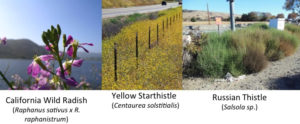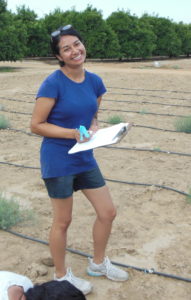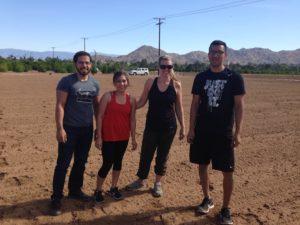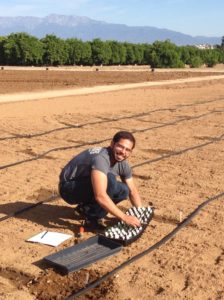My research is focused on the evolutionary ecology of invasive and weedy plants, specifically how the genome structure evolves following introduction or in response to human management. I use a variety of approaches ranging from field and common garden experiments to molecular and chromosome analyses to understand how plant species evolve in novel environments. My work draws from the fields of genetics, genomics, evolution and ecology to link shifts in genome structure with shifts in fitness and traits. My studies of invasive species aim to provide both fundamental insights into biology and practical information to land-managers regarding control of invasive species.

GENETIC ARCHITECTURE OF ADAPTATION AND THE ROLE OF HYBRIDIZATION IN WILD RADISH
I am using a combination of genomics and functional trait experiments to investigate how California wild radish has adapted across a climate gradient. California wild radish is a hybrid between wild radish (Raphanus sativus, Brassicaceae) and crop radish (R. raphanistrum) and has a wide distribution in California. This project addresses three major questions: 1) How does the genome evolve following hybridization? 2) What is the role of crop genes in adaptation following crop-wild hybridization across a climatic gradient?; and 3) How do functional traits vary along this climatic gradient? California wild radish is an ideal system in which to study weed genome evolution because it is a widespread weed that is closely related to crop radish, which has a genome assembly in process, and is in the same family as Arabidopsis thaliana, the model system for plant genomics. The genomic resources available in this system give me the power to utilize a whole genome approach to determine the relative role of regulatory element, gene and genome structure evolution in adaptation.
The role of introgression in adaptive evolution following hybridization between crops and their wild progenitors is an open question in weed evolution and is critical to evaluating the risks associated with transgenic crops. I am using whole genome resequencing approach to determine the relative contribution of each of the progenitors (crop and wild radish) to the genome of California wild radish across a climatic gradient. Understanding the relative role of crop genes in evolution requires understanding not just what percentage of the genome is composed of crop genes, but how often both crop and wild genes are the targets of selection. I am using statistical techniques to identify loci that are associated with adaptation to climate (LFMM and Gradient Forest) and appear to be under selection based on genomic signatures (Tajima’s D and Fst outlier tests). These tests additionally allow me to determine the role of genes that are under selection (regulatory vs. protein coding). Additionally, in collaboration with my mentor Dr. Jennifer Funk, I am working to understand the role of functional trait evolution (i.e. photosynthetic rate, water-use efficiency, growth rate, specific leaf area) in adaptation to a climate gradient utilizing the populations that are being characterized in the genetic studies. This approach allows us to identify genes that underlie functional traits of importance to adaptation and move to further understand the relative role of gene evolution versus regulatory evolution in adaptation. The next steps in this research are to determine the genomic shifts associated with functional trait evolution through genome wide associated studies conducted on recombinant lines from disparate regions of the range.
EVOLUTIONARY ECOLOGY OF AN ALLOPOLYPLOID TUMBLEWEED
Allopolyploid speciation occurs when hybridization between divergent lineages is followed by whole genome duplication, which restores correct meiotic pairing and fertility to what might otherwise be a sterile hybrid. This results in a novel stable hybrid genome and reproductive isolation from the progenitor species. Recently available data from next-generation sequencing has demonstrated that polyploidy has played a major role in angiosperm evolution and illuminated the need for studies investigating evolution in recently formed polyploids. Moreover, both hybridization and whole genome duplication have been proposed to lead to the evolution of invasive species [2,3], making the role of allopolyploidy in plant evolution a particularly exciting topic. My previous research addressed the evolutionary ecology of a newly formed allopolyploid species. Salsola ryanii (Amaranthaceae) is an allopolyploid neospecies, formed through hybridization between two invasive species also within the genus Salsola (tumbleweeds). I showed that this species has undergone the most rapid known range expansion of an allopolyploid species [4] and has increased in fitness relative to its progenitor species. I also determined that this neospecies is the result of multiple origins reflecting repeated independent allopolyploidization events and abundant opportunities for this major evolutionary transition in the genome to contribute to invasion [5]. I will continue to use Salsola as a system to understand the role allopolyploidy in shaping invasive neospecies. The role of multiple independent origins of allopolyploid species in the success of allopolyploid neospecies is not well understood. I will build upon my previous work to understand range increase of different lineages through time, their trait differences, and competitive performance to determine how origins influence variation in fitness and invasiveness. Salsola is an exciting system to bring public interest to plant biology because it is a group that if familiar to many people through popular culture. This has generated strong press coverage of my past work (coverage in Newsweek, on several NPR stations including statewide in California and on several science blogs).
ADVISING RESEARCH
Throughout my research, I enjoyed working closely with undergraduate students including members of underrepresented minorities in higher education. To provide the basis for independent research, I involve students with lab and field studies, experimental design and statistical analysis. I am particularly proud that a group of students whom I mentored published a peer-reviewed journal article with an undergraduate first author focused on barriers to gene flow between maize and teosinte [6]. These students are all currently utilizing skills they learned through this process in graduate programs. I have found that this research provides excellent opportunities for student involvement because it allows students to experience field, greenhouse, and laboratory work creating well-rounded scientists and allowing students to determine in what research direction their interests and passions lie.



1 Hoffman AA, Sgro CM, and Weeks AR (2004) Trends in Ecology and Evolution 19(9):882-488. 2 Ellstrand NC and Schierenbeck KA (2000) Proceedings of the National Academy of Sciences 97(13):7043-7050. 3 Pandit MK, Pocock MJO, and Kunin WE (2011) Journal of Ecology 99(5):1108-1115. 4 Welles SR and Ellstrand NC (2015) American Journal of Botany 103(4):663-667. 5 Welles SR and NC Ellstrand (2016) Evolutionary Applications 9(7):781-787. 6 Chavez NB, Flores JJ, Martin J, Ellstrand NC, Guadagnuolo R, Heredia S, Welles SR (2012) Economic Botany 66:132-137.